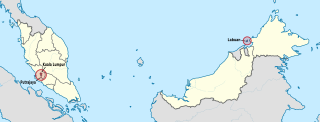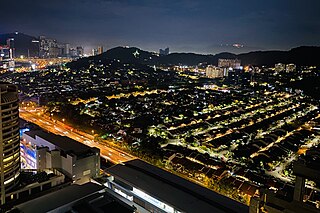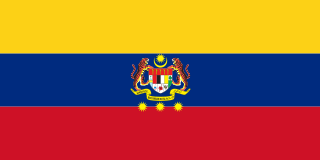
Kuala Lumpur, officially the Federal Territory of Kuala Lumpur, and colloquially referred to as KL, is the capital city and a federal territory of Malaysia. It is the largest city in the country, covering an area of 243 km2 (94 sq mi) with a census population of 2,075,600 as of 2024. Greater Kuala Lumpur, also known as the Klang Valley, is an urban agglomeration of 8.8 million people as of 2024. It is among the fastest growing metropolitan regions in Southeast Asia, both in population and economic development.

The Federated Malay States was a federation of four protected states in the Malay Peninsula — Selangor, Perak, Negeri Sembilan and Pahang — established in 1895 by the British government, and which lasted until 1946. In that year they formed the Malayan Union together with two of the former Straits Settlements,, and the Unfederated Malay States. Two years later, the union became the Federation of Malaya, which achieved independence in 1957, and finally Malaysia in 1963 with the inclusion of North Borneo, Sarawak and Singapore.

The national flag of Malaysia, also known as the Stripes of Glory, is composed of a field of 14 alternating red and white stripes along the fly and a blue canton bearing a crescent and a 14-point star known as the Bintang Persekutuan. The 14 stripes, of equal width, represent the equal status in the federation of the 13 member states and the federal territories, while the 14 points of the star represent the unity among these entities. The crescent represents Islam, the country's state religion; the blue canton symbolises the unity of the Malaysian people; the yellow of the star and crescent is the royal colour of the Malay rulers, the red stripes represent bravery and the white stripes represent purity. It is in the stars and stripes family of flags.

The Federal Territories (FT), in Malaysia comprise three territories—Kuala Lumpur, Labuan, and Putrajaya—governed directly by the Federal Government of Malaysia. Kuala Lumpur is the national capital of Malaysia, Putrajaya is the administrative capital, and Labuan is an offshore international financial centre. Kuala Lumpur and Putrajaya are enclaves in the state of Selangor. Labuan is an island off the coast of Sabah.

The Sultan Abdul Samad Building is a late-19th century building located along Jalan Raja in front of Dataran Merdeka and the Royal Selangor Club in Kuala Lumpur, Malaysia. The building originally housed the offices of the British colonial administration, and was known simply as Government Offices in its early years. In 1974, it was renamed after Sultan Abdul Samad, the reigning sultan of Selangor at the time when construction began.
The Kuala Lumpur–Seremban Expressway East–West Link Expressway is a main expressway in Kuala Lumpur, Malaysia. This 8.1 km (5.0 mi) expressway links Kuala Lumpur in the north to Seremban, Negeri Sembilan in the south.

Taman Tun Dr Ismail is a mid-sized township in Kuala Lumpur, Malaysia. Situated on the border of Kuala Lumpur and Selangor, it is within the vicinity of other townships including Bandar Utama Damansara, Damansara Utama, Mutiara Damansara. It also neighbours Bukit Kiara and Sri Hartamas and is within easy access of Bangsar and Damansara Heights. This township is in the Federal Territory of Kuala Lumpur with Kuala Lumpur City Hall (DBKL) as its local authority. It is primarily a residential neighborhood with businesses ranging from retail shops, restaurants and offices. Menara Ken and Plaza VADS are the two high-rise office buildings in TTDI. The township was named after Tun Dr. Ismail bin Abdul Rahman, Malaysia's first ambassador to the United States and a Malaysian representative to the United Nations, before becoming Malaysia's Deputy Prime Minister in 1970. Taman Tun Dr. Ismail is often abbreviated as "TTDI".

The Kuala Lumpur City Hall is the city council which administers the city of Kuala Lumpur in Malaysia. This council was established after the city was officially granted city status on 1 February 1972. Their jurisdiction covers an area of 243 square kilometres.

The People's Plaza is a planned mixed-use skyscraper complex in Kuala Lumpur, Malaysia initiated during the 1990s. However the project, which had already commenced construction, stalled due to the 1997 Asian financial crisis. Attempts to revive the project have come and gone, but no progress has been made, and the construction site remains deserted as of 2024.

Wangsa Maju is a township and a constituency in Kuala Lumpur, Malaysia. This area is surrounded by Setapak, Taman Melati and Gombak district in Selangor. Wangsa Maju is one of the major suburbs in Kuala Lumpur.

Angkasapuri is the main governmental building for Malaysia's Ministry of Information and it is also the headquarters for Radio Television Malaysia (RTM) located in Lembah Pantai, Kuala Lumpur, Malaysia.
The flag and coat of arms of Kedah are the state symbols of Kedah, Malaysia. Few distinctions are present between the flag and coat of arms of the state, as the flag consists of only a red field with the state arms on the upper hoist.

The flag of the Federal Territories of Malaysia consists of three horizontal bars of yellow, blue, and red, with the coat of arms of Malaysia in the middle. It was officially adopted on 23 May 2006.
Taman Ibukota is a Malay majority township in Setapak, Kuala Lumpur, Malaysia. It is a large and rather old neighborhood dating back to the 1970s when Kuala Lumpur City Hall (DBKL) workers were given discounted rates to purchase the houses there.

Panggung Bandaraya DBKL is a historical theatre hall located across the Merdeka Square in Kuala Lumpur, Malaysia, at the junction of Jalan Tun Perak and Jalan Raja. Construction began in 1896 and was completely finished in 1904.

Jalan Ipoh is a major road in Kuala Lumpur, Malaysia. The road is named after the city of Ipoh in Perak. Its English name is called Ipoh Road.

KL Eco City, or KLEC for short, is a 25-acre integrated mixed-use development project in the city of Kuala Lumpur, Malaysia. The project is built at the site of former Haji Abdullah Hukum Village. The mixed development project is helmed by S P Setia Berhad under a joint-venture agreement with the Kuala Lumpur City Hall (DBKL). It is built in stages comprising 3 residential towers, one serviced apartment tower, 3 corporate office towers, 12 boutique office blocks and a retail mall.

Kuala Lumpur City Football Club, known simply as KL City FC, is a Malaysian professional football club based in Kuala Lumpur. The club competes in the Malaysia Super League, the top level of Malaysian football, and was founded in 1974 as Federal Territory by the Kuala Lumpur Football Association (KLFA). It was later renamed Kuala Lumpur FA and Kuala Lumpur United, before renaming to its current name in 2021.
Taman Sri Sinar is a township in Kuala Lumpur, Malaysia. It is located in the northwest of the Segambut constituency and is surrounded by Taman Sri Bintang, Segambut Jaya, Taman Seri Kepong Baru, Taman Bukit Segambut, Taman Segambut Aman and Taman Segambut Damai. It has an estimated population of 40,000 as of 2010. This township is in the Federal Territory of Kuala Lumpur with Kuala Lumpur City Hall (DBKL) as its local authority.

The Ministry of Federal Territories(Malay: Kementerian Wilayah Persekutuan; Jawi: كمنترين ولايه ڤرسكوتوان), abbreviated KWP, was a ministry and is now a department under the Prime Minister's Department of the Government of Malaysia that is in charge of overseeing the administration and development of all three Federal Territories in Malaysia; Kuala Lumpur, Labuan and Putrajaya.

















